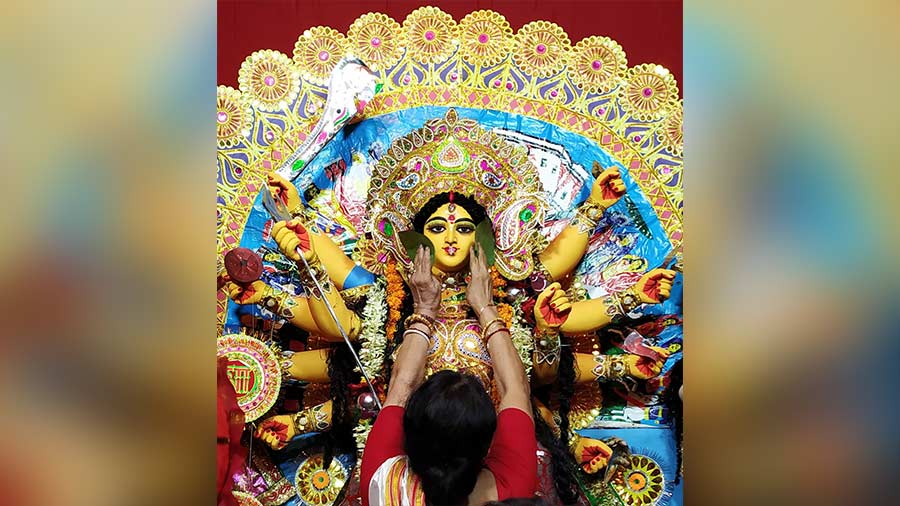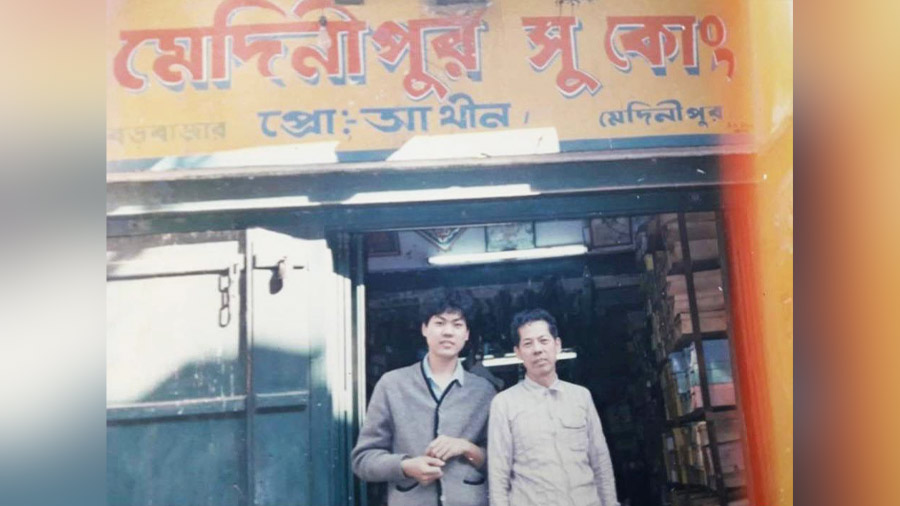Ramkishore Basu, the patriarch of the Basus of Aalgi village, Faridpur, now in Bangladesh, woke up with a start. He had had a most curious dream — a little girl dressed as Ma Durga came to him, and implored him to rescue her! She was trapped in the sandy bed of the river nearby, and wanted Ramkishore to find her and install her in the Basu family temple. It was almost the time of Durga Puja and the family, busy gearing up for its annual festivities, dismissed the dream.
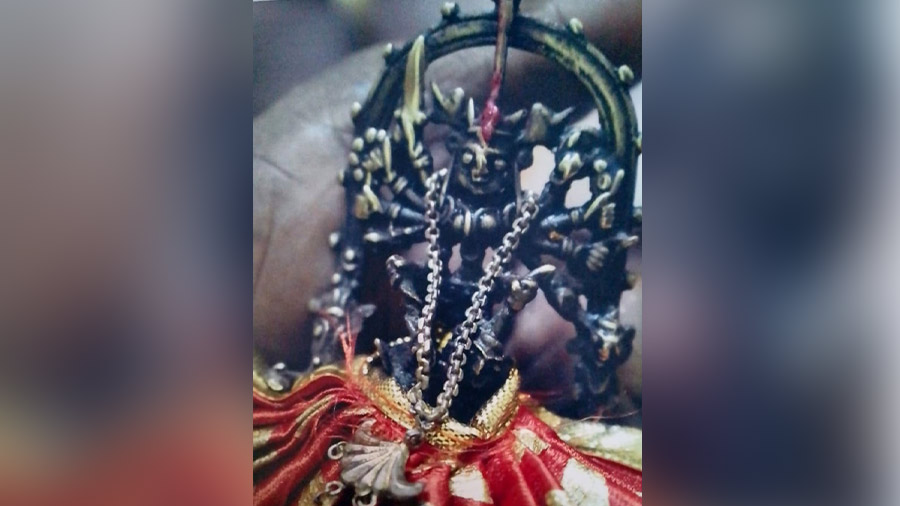
The ‘ashtadhatu’ idol of the goddess Photograph courtesy: Ujjaini Deb and Mou Majumdar
Ramkishore, however, could not shrug it off. He took two of his most trusted attendants, went to the spot described by the “little girl” in his dream, and started digging. In just a little while, they found her — a three-inch ashtadhatu idol of Ma Durga! He took her home and, as instructed, installed her as the family deity and worshipped her as Ma Annapurna.
The year was 1950. The Basus had fled to India post-Partition, but the Durga idol stayed in Faridpur, in the care of the family purohit and his sons. Even though his patrons had left, the purohit had kept the Basu family Durga Puja alive — not as grand an affair, but the rituals were as they had been for nearly 200 years. But times were getting more and more restless, and the purohit knew he wouldn’t be able to keep the idol safe for much longer.

‘Boron’ of the Devi by the Basu matriarch Photograph courtesy: Ujjaini Deb and Mou Majumdar
As he walked, ducked, and, at times, crept towards the Indian border, the septuagenarian kept his right hand inside the small cloth pouch that hung from his neck. Inside, his fingers wrapped around the idol of Annapurna that he wanted to deliver to his patron’s new home in Kolkata. Just knowing that his god was with him made the journey seem less daunting. And with that journey, the centuries-old Durga puja of the Basus of Faridpur— my mother’s side of the family— moved to India. Ever since, the family pujo has been hosted at the homes of the family scion, mostly spread across south Kolkata.
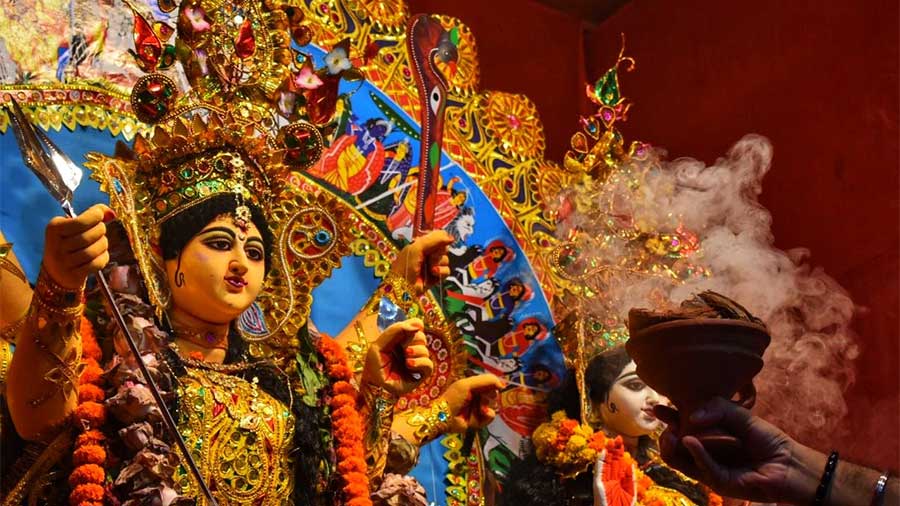
The goddess in all regalia at the Basu pujo Photograph courtesy: Ujjaini Deb and Mou Majumdar
In its 240th year now, the pujo has stayed very close to its original bed of traditions. One year, there was an effort to go beyond the ekchala protima and adopt the more barowari style with individual idols. But a fire broke out in the puja mandap that year, and the family took that as “a sign” and decided to go back to the ekchala form.
Over the years, the family has branched out and generations are spread across India, but it has always come together to celebrate the goddess’s homecoming every autumn. As my maternal uncles, aunts, cousins, nephews and nieces get ready for the family puja this year, I cannot help feeling waves of nostalgia sweep over me as I button the heavy fall jacket over my crisp Dhakai sari and head out to the weekend gala that is Durga Puja in the US. It may be Mahalaya in India, but time for sindoor khela at the community Durga puja here in Boston. But, as they say, when life gives you lemons…
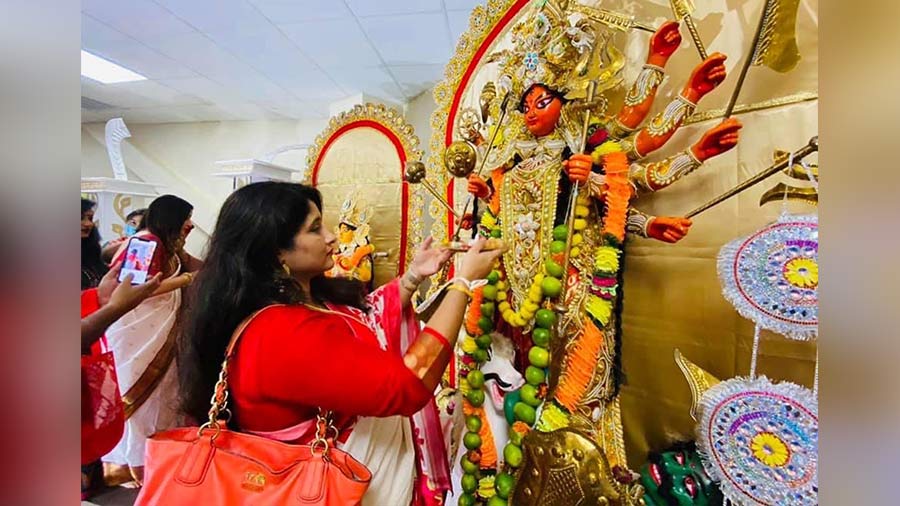
‘Boron’ at Prabasi of New England Durga Puja in Boston Dipanwita Bhattacharyya / Facebook
I moved to the US in 2005, and that was the last time I attended our barir pujo. But the memories remain vivid. The months of planning, the setting up of the ghot 15 days before Maha Navami and the Pujo fervour it unleashed, bringing the idol home, cousins getting together to adorn her with the heirloom jewelry and Ma’s weapons. The 4am wake-up calls to get the naibedyo and other offerings ready for the day’s pujo, the smell of the narkel naru mixture churning away in an iron kadhai over a clay unoon, my Boro Mashi watching the purutmoshai’s moves like a hawk to make sure that every tradition is followed perfectly. My youngest nephew running away with the dhaaki’s sticks because he was not allowed to play the dhaak, us descending on that first batch of jibhe goja as soon as it emerged from the syrup, practising our dhunuchi naach before Maha Saptami came around, wrapping the anachal of my taant-er sari tightly around the waist as I picked up a tub of steaming khichuri to serve the guests. And then as Dashami came by, the melancholy that enveloped us all as the idols were loaded onto the trucks. The bhashaan procession, however, soon brought the smiles out, as the whole family crowded onto the trucks and sang our hearts out all the way to Babughat.

The ‘anjali’ at Bengalees of New England Durga Puja in Boston Dipanwita Bhattacharyya / Facebook
A blizzard of activity and emotions over just a few days. A lifetime of memories, beautiful and heart-warming.
But now, it is back to the lemons and the lemonade! Parobashe Pujo — I still remember my first time at a Durga Puja in the US. I was a graduate student at UNC Chapel-Hill, missing home and my barir pujo terribly. I didn’t know what to expect as I hesitantly walked into the community centre in Cary in 2006, not knowing a soul there and certainly not yet understanding the adaptations that the pujos here have to make. Why on earth are we celebrating Durga Puja four days before Maha Sasthhi? What’s with the constant clamour for performance slots for the cultural programme? Why are they not allowing us to place the flowers at the feet of the goddess after the anjali? Who serves pizza at a pujo, even if it’s just for the kids? Where’s the dhaak and the dhaaki? How can they reuse the same idol every year?
Seventeen years down the line, none of those questions matter anymore. I am just grateful that sitting 7,757 miles away from home, I still have the opportunity to celebrate Durga Puja in whatever adapted form it may be. There are multiple Bengali associations that put on their own pujos on successive weekends, so one can either take their pick or do a complete pujo parikrama. Boston itself has six Durga pujas spread over two weekends! So while the Pujo has shrunk to two days (mostly) for us here in the US, we do have the opportunity to celebrate it over and over again. You can watch artistes of the stature of Srikanta Acharya, Lopamudra Mitra, Chandrabindoo, even Bollywood stars like Sudesh Bhosale on two consecutive weekends. Dinners, however sumptuous, are sometimes pushed to the back burner as you rush from one pujo to another so that you do not miss your favourite performer. Above all, the puja here brings together the Bengali diaspora in solidarity and celebration like nothing else.
Yes, we cannot follow every ritual exactly as it should be — yes, sticklers for tradition may not approve. But the lemonade we make with the lemons that we have available has its own charm. It may not be as lip-smackingly good, a little shy on the bit nun, but lemonade it is!
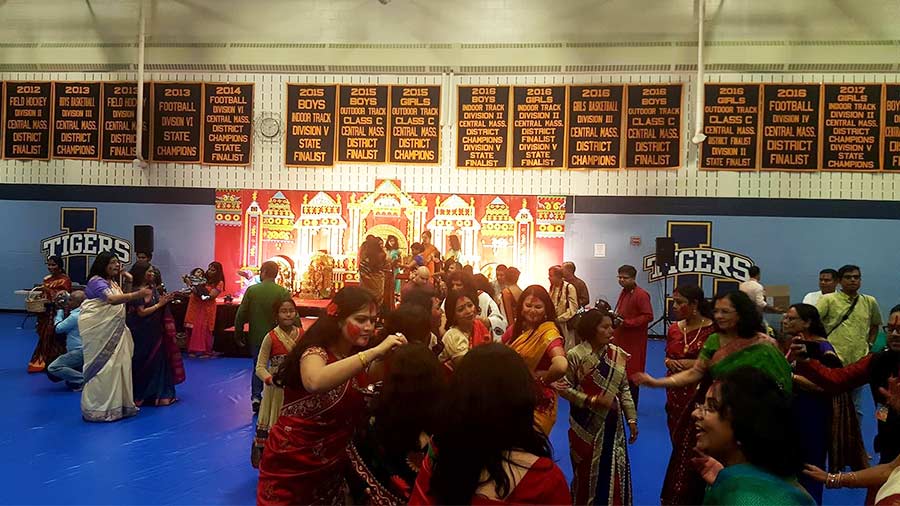
‘Sindoor khela’ at Bangla O Biswa Durga Puja in Boston Dipanwita Bhattacharyya / Facebook
Dipanwita Bhattacharyya is a social sector professional based in Boston.
